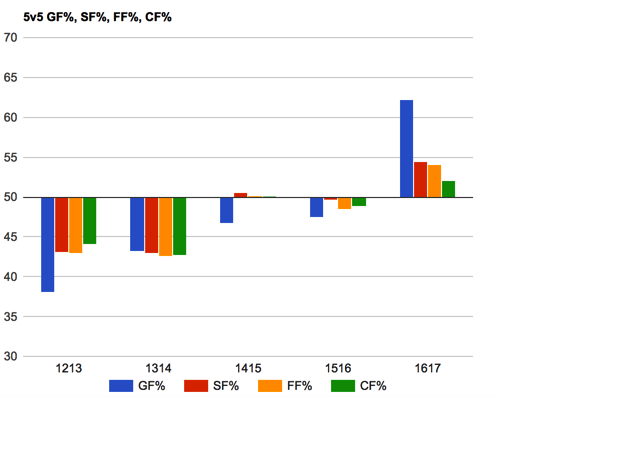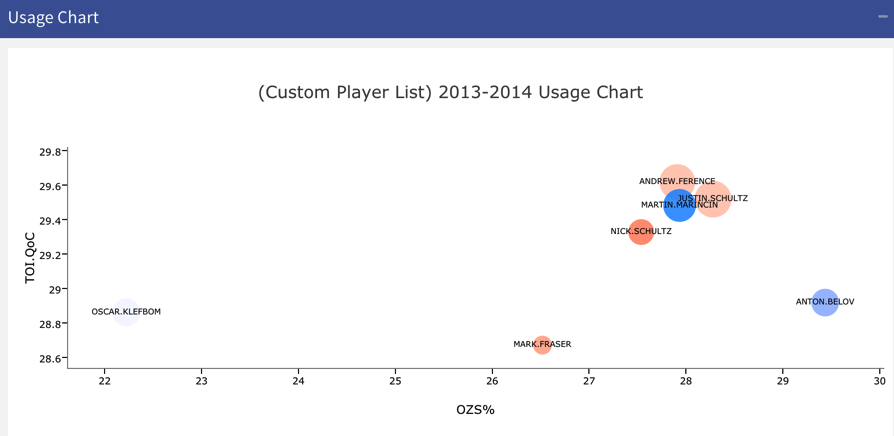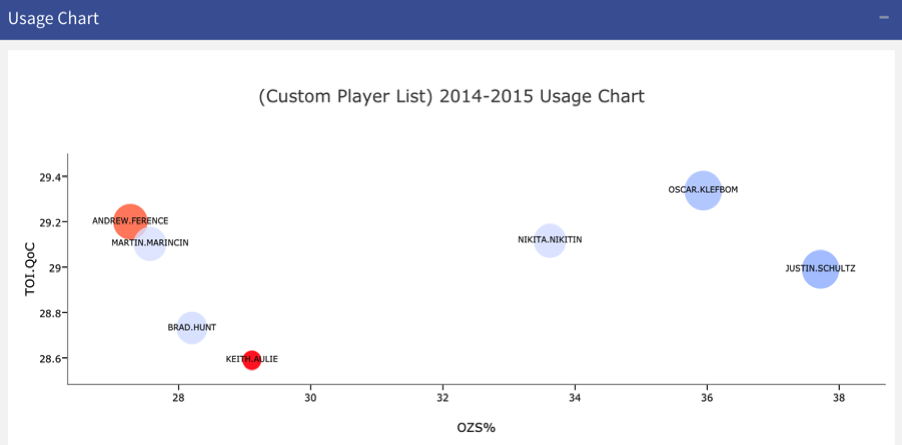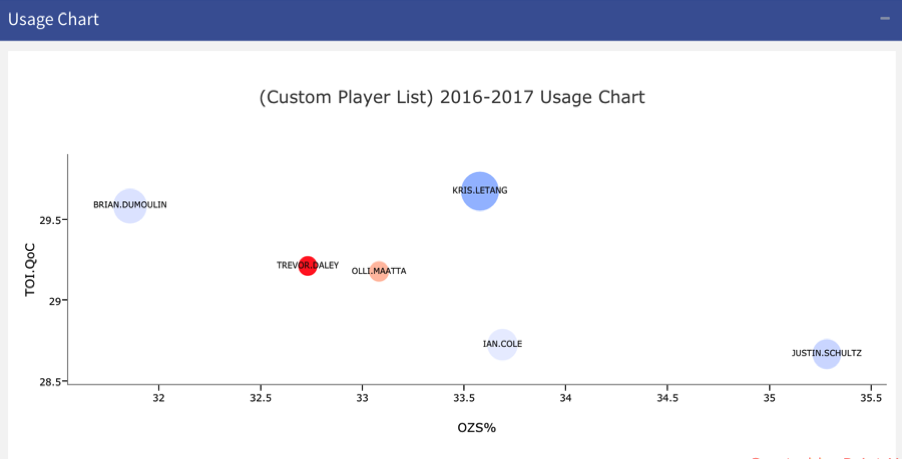<
It has quite literally been a complete turnaround for Schultz, who is shattering his previous marks for Goals-For, Shots-For, Fenwick-For, and Corsi-For. Sure, some of that has to do with the Penguins being a significantly better hockey team, but the story on Schultz goes much, much deeper than that.
Mike Sullivan is deploying Justin Schultz to situations that suit his strengths as a defenseman.
This point cannot be understated enough. Schultz, as was proven in his time with the Oilers, is not a defender that is capable of handling tough minutes against the other teams top lines.
That’s not a criticism of Schultz. It’s a reality of life in the NHL. Coaches are tasked with making decision about what pairing goes up against the other teams forwards. These matchups dictate entire games. In addition to those match-up decisions, coaches are also responsible for knowing when to deploy players in the offensive or defensive zone for upcoming faceoffs. In these decisions, the Edmonton Oilers did not employ Schultz to his strengths.
Let’s visualize Schultz’s deployment over the last several seasons to get a gauge of how he’s being used differently with the Penguins.
(Data here courtesy of Corsica.Hockey)
On the following charts, we’ll look at a defenders deployment over the course of an NHL season. The vertical axis will track quality of competition; the higher a defenseman appears on this chart, the tougher his quality of competition. The horizontal axis will track offensive zone deployment percentage; the percentage of faceoffs a defenseman took in the offensive zone. The dots will be colored by puck-possession percentage.
Let’s go back to 2013/14 to look at how the Oilers used Schultz:
In 2013/14, Schultz and Andrew Ference took the toughest assignments from a quality-of-competition standpoint. Although Schultz was given a decent amount of offensive zone starts, he was still tasked with taking on the other teams top lines in even-strength situations. As we saw in the chart above that tracked his season-by-season data, this resulted in one of the worst years of his career.
In 2014/15, the Oilers tempered his deployment a little bit. His competition level was slightly softened and his offensive zone starts went up about 10%, but not enough to really top the scales:
At the end of the day, Schultz was still being asked to do a bit too much. As his confidence level appeared to wane, things continued to get worse. When he was traded to the Penguins the following season, people deemed it a “reclamation project” that would take time to pay dividends to Pittsburgh. Instead, with Trevor Daley on the shelf, Schultz stepped right into the Stanley Cup Playoffs and put forth some of the best performances of his career.
Now, obviously, the Penguins are/were in a much different position than the rebuilding Oilers. But a better quality of teammate isn’t the only thing that changed for Schultz. He didn’t magically become one of the more offensively potent defensemen in the league.
The Penguins coaching staff has put Schultz in a position to post these kinds career-record numbers. Let’s take a look at the visual of the Penguins defensive deployment this season:
Mike Sullivan and his staff are deploying Schultz in a way that completely suits his strengths. He’s taking minutes alongside Ian Cole against lower-level competition and he’s being fed a ton of offensive zone starts; more than anyone on the team in that regard.
Again, this isn’t a slight on the performance of Schultz this season. This is common sense coaching: deploy your players to the best of their ability. You don’t ask offensive oriented defenseman who comfortably slot into a 4-6 position on your blueline to have a heavy load of defensive zone starts against the other teams top lines just like you wouldn’t ask your dog to meow like a cat. This is simply good asset management by Sullivan & Co.
It also helps that Schultz toolbox of skills fit the Penguins scheme perfectly.
Let’s jump into some video on how Schultz has aided the Penguins from a mobility and puck-movement perspective this season.
To start, Schultz is adept at identifying disadvantageous situations on the breakout and offering an extra body to break the play up ice.
This instance against the Flames is the perfect example of creating an outlet and taking the ice available to you. With the Penguins forwards tied up along the boards and the Flames pressing on the forecheck, Schultz makes himself available in the middle of the ice for an easy tape-to-tape pass. He builds speed through the neutral zone and puts the Flames defense on its heels.
Schultz also provides a reliable and creative presence on the breakout:
In this sequence we can see Schultz testing the Tampa forecheck. He heads back into his own zone, re-starts the breakout, looks for a lane up ice, and then reverses the play away from the Tampa forecheck to put the puck in a clear sheet of ice.
All too often you see defensemen force plays that aren’t there. They try to fit the puck in-between three or four bodies onto the stick of a teammate. In this instance, we see Schultz do the exact opposite. He’s patiently testing the Tampa neutral zone presence for a weakness, and when it doesn’t present itself, he reverses the play so his partner can get a clean pass up ice. The entire Tampa Bay defense shifted to the left side to account for the faux-rush by Schultz, and he immediately reversed this play to open up a clean sheet of ice for his teammates.
And finally, in what might be his best asset to the team this season, Schultz is extremely keen on identifying opportunities to head up ice and join the rush offensively.
In this breakout sequence, Schultz has shifted with a forward and finds himself in the high slot of the defensive zone. As this puck squeezes out of a board-battle to the stick of Chris Kunitz, Schultz is off to the races. His awareness of Kunitz as his trailer enables the Penguins to garner a solid scoring chance because of his presence of mind to jump into the play.
In conclusion, both the Penguins front office, coaching staff, and Schultz individually deserve a lot of credit for turning this thing around. A little dose of correct deployment, combined with the natural abilities of Schultz with a renewed sense of confidence has given the Penguins an ace on their bottom pairing.]]>
Add The Sports Daily to your Google News Feed!





